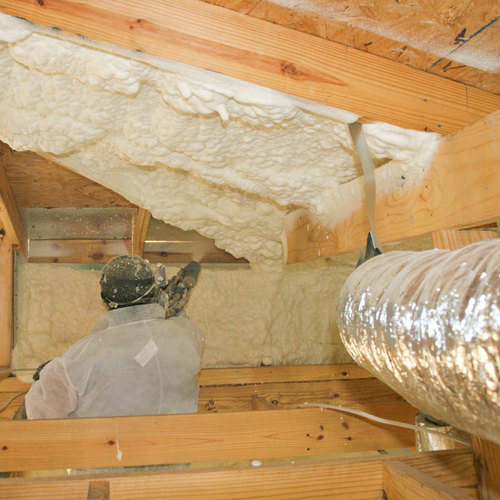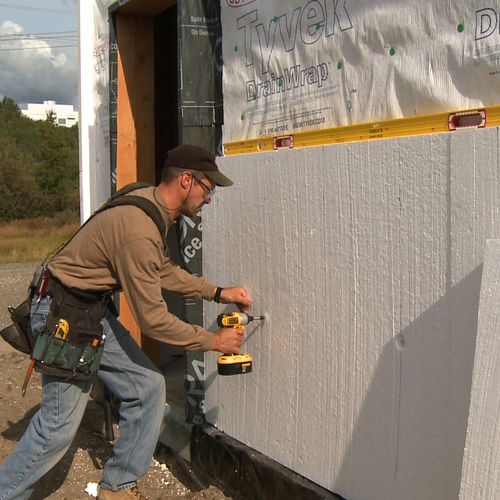##ABOUT BLOWN-IN OR LOOSE-FILL INSULATION
Typical wall and ceiling cavities aren’t uniform in size; some are 22 1/2 in. wide, while others are narrow. They can include electrical boxes, wiring, plumbing vents, and blocking. Because of these variations, it’s hard to get batt insulation to conform to all the voids in a stud or joist bay.
In contrast, blown-in insulation provides better performance than batts by filling odd-shaped cavities completely.

This article is only available to GBA Prime Members
Sign up for a free trial and get instant access to this article as well as GBA’s complete library of premium articles and construction details.
Start Free TrialAlready a member? Log in









9 Comments
I need some help on insulation
I built my house 4 years ago and used fiberglass blown-in insulation in the attic. I went up and found that the fiberglass has settled down about 4 in., so i am going to get more insulation to blow in. But do I use more fiberglass or do I get some cellulose and blow it on top of the old fiberglass ?
Either one
Ryan,
1. Either product will work. If it were my own house, I'd choose cellulose.
2. Remember, more insulation is better than less. As long as you're installing more insulation, you might as well install as much as you can afford.
ORNL Study
Martin
The article I have in my files from Home Energy, May/June 1992, discussing the ORNL tests, indicate that the R-value of the blown fiberglass began deteriorating at approximately 30 degrees F, due to convection currents within the product. I believe the University of Illinois arrived at similar information under testing they performed on blown fiberglass. From personal history, I can attest that homes with blown fiberglass have higher ACH under a blower door test and have higher energy consumption than similar homes with cellulose.
Response to Bryce
Bryce,
Thanks for your post. You bring up some important concerns. I discuss some of these issues, and more, in my recent Fine Homebuilding article, Blown Insulation for Attics: Fiberglass vs. Cellulose.
Here are the links:
http://www.finehomebuilding.com/how-to/articles/blown-insulation-for-attics-fiberglass-vs-cellulose.aspx?ac=fp
http://www.finehomebuilding.com/PDF/Protected/021216059.pdf
Vapor barrier
I live in Northern Michigan. What about vapor barriers and cellulose in new home construction? I am building with a double wall 8-10" of cellulose.
Response to Charles Eichenlaub
Charles,
In your climate, most building codes require a vapor retarder, not a vapor barrier, on the inside of your wall. You should avoid the use of polyethylene. Vapor-retarder paint (over the drywall) will work fine.
Of course, airtight construction techniques are much more important than whether or not you include a vapor retarder. Do your best to seal all air leakage points.
Here is more information on vapor retarders:
Vapor Retarders and Vapor Barriers
Forget Vapor Diffusion — Stop the Air Leaks!
I have seen mineral wool as a blown insulation option, and I wonder how it compares to fiberglass and cellulose. I know it is flame retardent, but does it settle? Can it be damp-sprayed like cellulose? Does it stop air movement as much as cellulose?
Jmbf,
I'm no expert on it, but I've looked into before.
American Rockwool Premium Plus is a brand that comes to mind. They recommend blowing in the mineral wool at 4# density which is similar to cellulose and 2X+ blown in fiberglass. I would guess that cellulose is still a bit less air permeable however. Not sure about settling.
The product can be sprayed in but it isn't a wet spray so much as it is sprayed in with a binder (like JM Spyder). I'm going on memory here...
Of course the big performance difference between mineral wool/fiberglass and cellulose is that mineral wool is hydrophobic and cellulose is hydroscopic. Cellulose keeps moisture away from your sheathing and studs. Mineral wool (like fiberglass) will not.
Great point on the moisture handling Rick. That probably solves it there for me. Much appreciated.
Log in or become a member to post a comment.
Sign up Log in